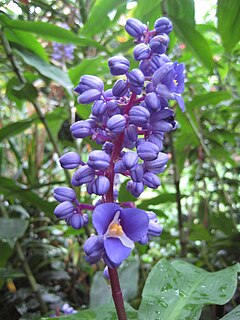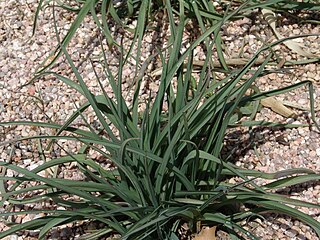
Tradescantia is a genus of 75 species of herbaceous perennial wildflowers in the family Commelinaceae, native to the New World from southern Canada to northern Argentina, including the West Indies. Members of the genus are known by the common names wandering Jew or spiderwort. Other names used for various species include spider-lily, cradle-lily, oyster-plant and flowering inch plant.

Commelinaceae is a family of flowering plants. In less formal contexts, the group is referred to as the dayflower family or spiderwort family. It is one of five families in the order Commelinales and by far the largest of these with about 731 known species in 41 genera. Well known genera include Commelina (dayflowers) and Tradescantia (spiderworts). The family is diverse in both the Old World tropics and the New World tropics, with some genera present in both. The variation in morphology, especially that of the flower and inflorescence, is considered to be exceptionally high amongst the angiosperms.

Dichorisandra thyrsiflora or blue ginger is a species of tropical flowering plant which resembles ginger in growth and habit, but is actually related to the spiderworts. The plant is native to the tropical woodlands of North, Central and South America, especially in Atlantic Forest vegetation in Brazil. Of the family Commelinaceae, it is cultivated for its handsome spotted stems and large shiny foliage which is held horizontally, surmounted by striking blue flowers.

Cochliostema is a genus of plants with two species in the family Commelinaceae. The genus occurs from southern Nicaragua to southern Ecuador.
PlowmanianthusFaden & C.R.Hardy is a genus of plants with 5 species and 2 subspecies in the family Commelinaceae. The genus is distributed from Panama to Amazonian Peru and Brazil.

Commelina benghalensis, commonly known as the Benghal dayflower, tropical spiderwort, or wandering Jew, kanshira in Bengali, is a perennial herb native to tropical Asia and Africa. It has been widely introduced to areas outside its native range, including to the neotropics, Hawaii, the West Indies and to both coasts of North America. It has a long flowering period, from spring to fall in subtropical areas, and throughout the year closer to the equator. It is often associated with disturbed soils.
David Richard Hunt was an English botanist and taxonomist. He was a specialist in cacti and the spiderwort family. He notably compiled the 1999 CITES Cactaceae Checklist.

Tradescantia occidentalis, the prairie spiderwort or western spiderwort, is a plant in the dayflower family, Commelinaceae. It is common and widespread across the western Great Plains of the United States, as well as in Arizona, New Mexico, southern Utah, and Sonora, but is listed as a threatened species in Canada.

Tradescantia ohiensis, commonly known as bluejacket or Ohio spiderwort, is an herbaceous plant species in the genus Tradescantia native to eastern and central North America. It is the most common and widely distributed species of Tradescantia in the United States, where it can be found from Maine in the northeast, west to Minnesota, and south to Texas and Florida. It also has a very small distribution in Canada in extreme southern Ontario near Windsor.

Dichorisandrinae is a subtribe within the tribe Tradescantieae of the flowering plant family Commelinaceae. It consists of 5 genera and around 51 species.

Tradescantia ozarkana, the Ozark spiderwort, is a species of Tradescantia. It is part of the Commelinaceae family, native to the States of Missouri, Arkansas, and Oklahoma in the south-central United States. It flowers from April to May and can be found in rich, rocky areas, including woods and bluff ledges.

Tradescantia crassula, common names succulent spiderwort and white-flowered tradescantia, is a species of plants in the Commelinaceae. It is native to southeastern Brazil, Uruguay, and the Misiones Province of Argentina, and has been introduced to Florida. It flowers in May in Florida, and can be found under Oak Trees.
Tradescantia pinetorum, the pinewoods spiderwort, is a species of Tradescantia and part of the Commelinaceae family.

Geogenanthus poeppigii, commonly called the seersucker plant, is a flowering plant species in the family Commelinaceae. As currently circumscribed, the genus Geogenanthus includes two other species, G. ciliatus and G. rhizanthus. This species is named after E.F. Poeppig, 19th century German explorer. Geogenanthus undatus is an outdated synonym for G. poeppigii. For more details on the rather complicated synonym for this species, see Faden (1981).

Geogenanthus ciliatus is a flowering plant species in the family Commelinaceae. As currently circumscribed, the genus Geogenanthus includes two other species, G. poeppigii and G. rhizanthus.

Cartonema is a genus of perennial or annual monocotyledonous flowering plants in the dayflower family. It is restricted to Australia and nearby Trangan Island, which is part of Indonesia. It is the earliest diverging member of its family and has a number of traits that are unique within it, such as non-succulent leaves and a lack of raphides. Its distinctive features led to the genus to once be considered part of its own separate family, Cartonemataceae. However, analysis of DNA sequences, as well as many common anatomical characters, has supported its relationship with the Commelinaceae. It contains about 11 species.

Triceratella is a genus of annual monocotyledonous flowering plants in the dayflower family. The genus consists of a single species, Triceratella drummondii. It is known to occur in Zimbabwe and Mozambique, but has only been collected twice. Because of its rarity, DNA sequences have never been used to determine its relatives, but it is believed to be closely related to the early diverging genus Cartonema, with which it shares a number of characters unique for the dayflower family, such as a yellow flowers, glandular hairs, and a lack of glandular microhairs. It differs from Cartonema, however, in having raphides, which all other members of the Commelinaceae have, although they occur in a unique position next to the leaf veins in Triceratella.

Tradescantia sillamontana is a perennial evergreen herbaceous plant of the genus Tradescantia. This species is one of the most succulent and xerophytic, but at the same time one of the most attractive species of Tradescantia. It is endemic to dry areas of the State of Nuevo León in northeastern Mexico.
Tradescantia buckleyi, commonly known as Buckley's spiderwort, is a species of flowering plant in the dayflower family, Commelinaceae. It is native to southern Texas in the United States as well as northern Tamaulipas in Mexico. The specific name honours Samuel Botsford Buckley (1809-1884), who collected the type specimen near Corpus Christi, Texas.














